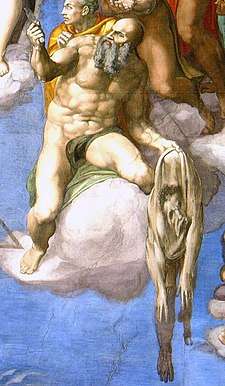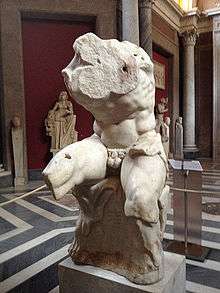Belvedere Torso
The Belvedere Torso is a fragmentary marble statue of a nude male, known to be in Rome from the 1430s, and signed prominently on the front of the base by "Apollonios, son of Nestor, Athenian", who is unmentioned in ancient literature. It is now in the Museo Pio-Clementino (Inv. 1192) of the Vatican Museums.

It was once believed to be a 1st-century BC original,[1] but is now believed to be a copy from the 1st century BC or AD of an older statue, which probably dated to the early 2nd century BC.
Description
The figure is portrayed seated on an animal hide, and its precise identification remains open to debate. Though traditionally identified as a Heracles seated on the skin of the Nemean lion, recent studies have identified the skin as that of a panther, occasioning other identifications (with possibilities including Hercules, Polyphemus and Marsyas).[2] According to the Vatican Museum website, "the most favoured hypothesis identifies it with Ajax, the son of Telamon, in the act of contemplating his suicide".[3]
History after rediscovery
The statue is documented in the collection of Cardinal Prospero Colonna at his family's palazzo in Monte Cavallo, Rome from 1433,[4] not because it elicited admiration but because an antiquarian epigrapher, Ciriaco d'Ancona (or someone in his immediate circle) made note of its inscription;[5] a generation later it began its career as a catalyst of the classical revival. Early drawings of the Torso were made by Amico Aspertini, c. 1500–03, by Martin van Heemskerck, c. 1532–36, by Hendrick Goltzius, c. 1590; the Belvedere Torso entered the visual repertory of connoisseurs and artists unable to go to Rome through the engraving of it by Giovanni Antonio da Brescia, c. 1515.[6] Around 1500 it was in the possession of the sculptor Andrea Bregno. It was still in the Palazzo Colonna during the Sack of Rome in 1527, when it suffered some mutilation.[7]
Between 1523 and 1534, the sculpture was in the Vatican.[4] The contorted pose of the torso and musculature were highly influential on Renaissance, Mannerist, and Baroque artists, including Michelangelo and Raphael. Michelangelo's admiration of the Torso was widely known in his lifetime,[8] to the extent that the Torso gained the sobriquet, "The School of Michelangelo".[9] Legend has it that Pope Julius II requested that Michelangelo complete the statue fragment with arms, legs and a face. He respectfully declined, stating that it was too beautiful to be altered, and instead used it as the inspiration for several of the figures on the Sistine Chapel ceiling, including the Sibyls and Prophets along the borders, and both the risen Christ and St. Bartholomew in The Last Judgement.[10] The Belvedere Torso remains one of the few ancient sculptures admired in the 17th and 18th centuries whose reputation has not suffered in modern times.[11]
How it entered the Vatican collections is uncertain, but by the mid-16th century it was installed in the Cortile del Belvedere, where it joined the Apollo Belvedere and other famous Roman sculptures. "The Laocoön took two months from unearthing to Belvedere canonization," Leonard Barkan observed, "the Torso took a hundred years."[12]
Several small bronze reductions of it were made during the 16th century,[13] often restoring it as a seated Hercules.[14]
The Belvedere Torso visited the British Museum for their 2015 exhibition on the human body in ancient Greek art.[15]
Gallery
 Greek inscription on the pedestal
Greek inscription on the pedestal- Front view showing pedestal, dark
 Belvedere Torso, frontal view
Belvedere Torso, frontal view The Belvedere Torso, 3/4 view.
The Belvedere Torso, 3/4 view.- Belvedere Torso, left side view
 Belvedere Torso, rear view, sunlit
Belvedere Torso, rear view, sunlit Belvedere Torso, right side view
Belvedere Torso, right side view Belvedere Torso detail, abdomen
Belvedere Torso detail, abdomen Belvedere Torso (foreground at right) in a capriccio by Giovanni Paolo Panini.
Belvedere Torso (foreground at right) in a capriccio by Giovanni Paolo Panini.- Drawing after the Belvedere Torso by Peter Paul Rubens, Rubenshuis (RH.S.109).
- Study after the Belevedere Torso by Peter Paul Rubens, Metropolitan Museum of Art.
 Print of the Belvedere Torso; Domenico De Rossi, Raccolta del Scultore Antiche e Moderne. 1704. Engraving. Plate IX. 28 × 29 cm.
Print of the Belvedere Torso; Domenico De Rossi, Raccolta del Scultore Antiche e Moderne. 1704. Engraving. Plate IX. 28 × 29 cm. Michelangelo being Shown the Belvedere Torso, Jean-Léon Gérôme, 1849. Dahesh Museum of Art.
Michelangelo being Shown the Belvedere Torso, Jean-Léon Gérôme, 1849. Dahesh Museum of Art.
Notes
- Winckelmann dated it to about 200 BC, a Greek work that had been imported to Rome (Geschichte 1764:368ff).
- Vinzenz Brinkmann: "Zurück zur Klassik." In: "Zurück zur Klassik. Ein neuer Blick auf das alte Griechenland." Hirmer, Munich 2013, pp. 55–57.
- http://mv.vatican.va/3_EN/pages/x-Schede/MPCs/MPCs_Sala06_01.html
- Regoli, Gigetta Dalli; Gioseffi, Decio; Mellini, Gian Lorenzo; Salvini, Roberto (1968). Vatican Museums: Rome. Italy: Newsweek. p. 22.
- Noted in Francis Haskell and Nicholas Penny, Taste and the Antique: the lure of classical sculpture, 1400–1900, 1981:311.
- All illustrated by Leonard Barkan, Unearthing the Past: Archaeology and Aesthetics in the Making of Renaissance Culture (Yale University Press, 1999) ill. 3.79–85.
- The earliest dated sketches show the right leg intact through the knee. The engraving by Giovanni Antonio da Brescia, c. 1515, through which it became widely known, showed it with its legs complete, an imaginary restoration, according to Leonard Barkan, Unearthing the Past: Archaeology and Aesthetics in the Making of Renaissance Culture (Yale University Press, 1999) p 193f.
- Ulisse Aldrovandi published Michelangelo's admiration for the Torso in "Delle statue antiche..." in Lucio Mauro, Le Antichità della città di Roma, Venice, 1556 (Haskell and Penny 1981:312).
- Edward Wright, Some Observations Made While Travelling through France, Italy &c... London, 1730, noted in Haskell and Penny 1981:313 note 25.
- Regoli, Gigetta Dalli; Gioseffi, Decio; Mellini, Gian Lorenzo; Salvini, Roberto (1968). Vatican Museums: Rome. Italy: Newsweek. p. 25.
- Noted by A. D. Potts, "Greek Sculpture and Roman Copies I: Anton Raphael Mengs and the Eighteenth Century" Journal of the Warburg and Courtauld Institutes 43 (1980:150–173) p. 150
- For its Renaissance career, Barkan 1999:190ff.
- Arvid Andrén, ""Il torso del Belvedere", Opuscula Archaeologica, 7 (Lund, 1952)
- For example a bronze statuette formerly in the von Pannwitz collection, by a follower of L'Antico (Diana M. Buitron, "The Alexander Nelidow: A Renaissance Bronze?" The Art Bulletin 55.3 (September 1973:393–400) p398).
- https://www.theguardian.com/artanddesign/2015/jan/08/belvedere-torso-british-museum-body-exhibition
External links

- The Belvedere Torso on the Vatican Museums website.